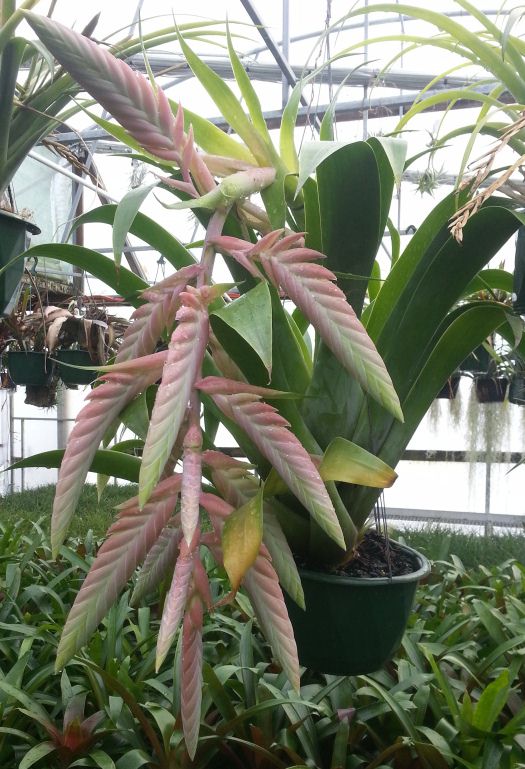
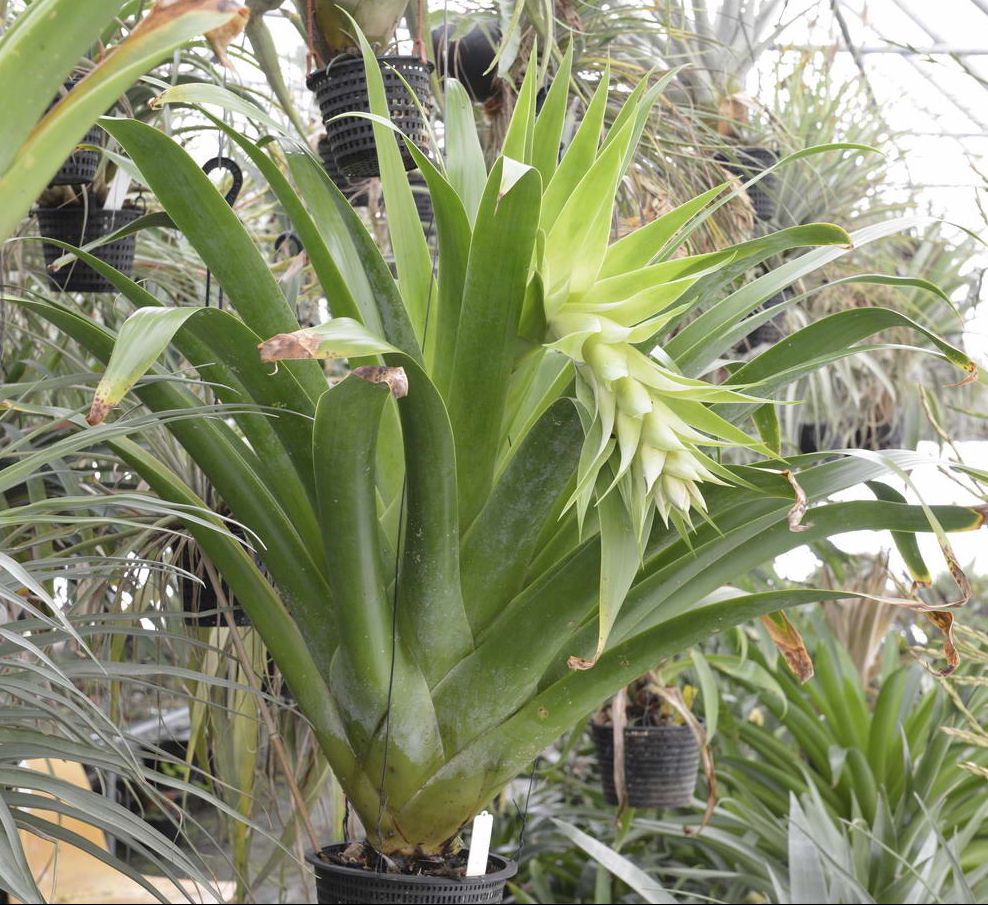
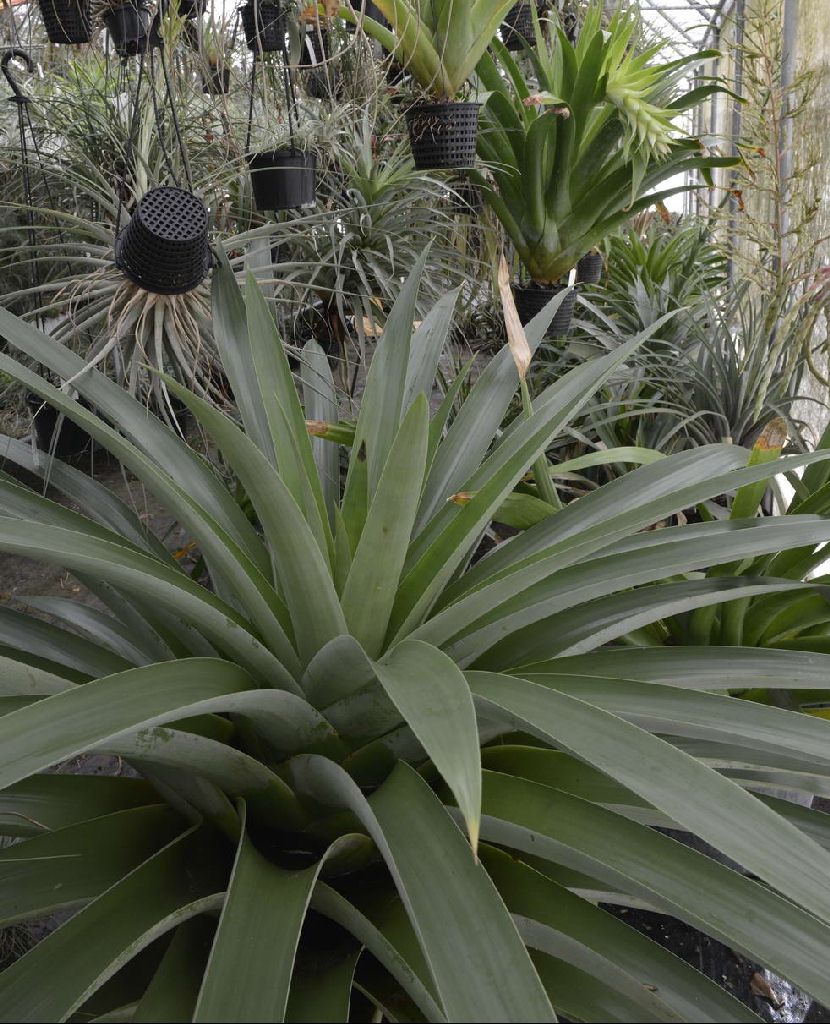
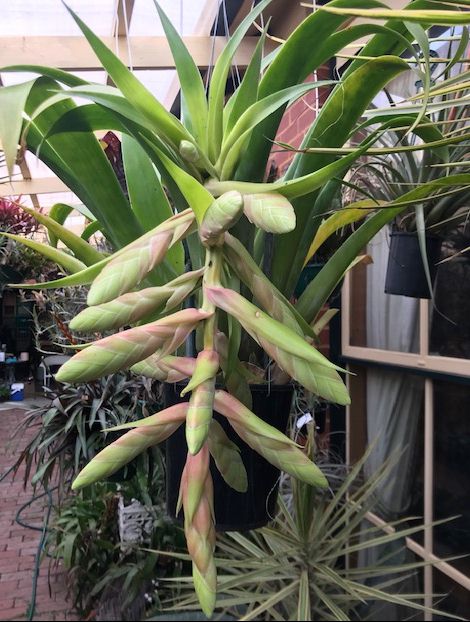
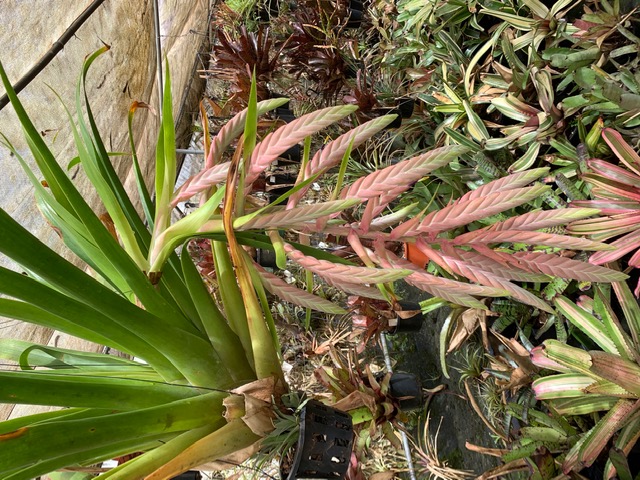
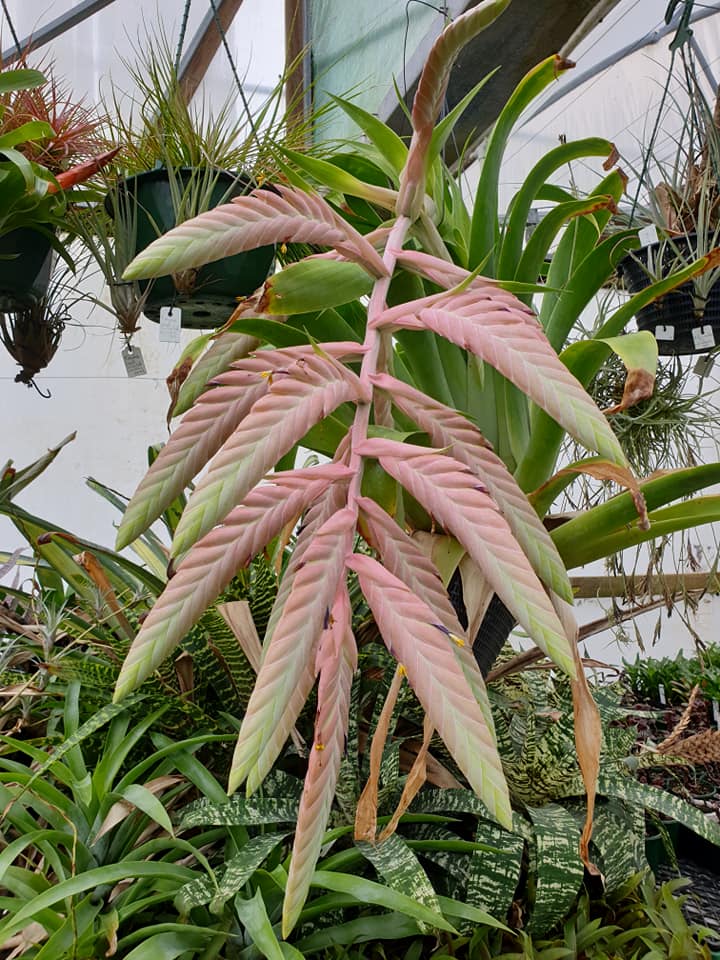
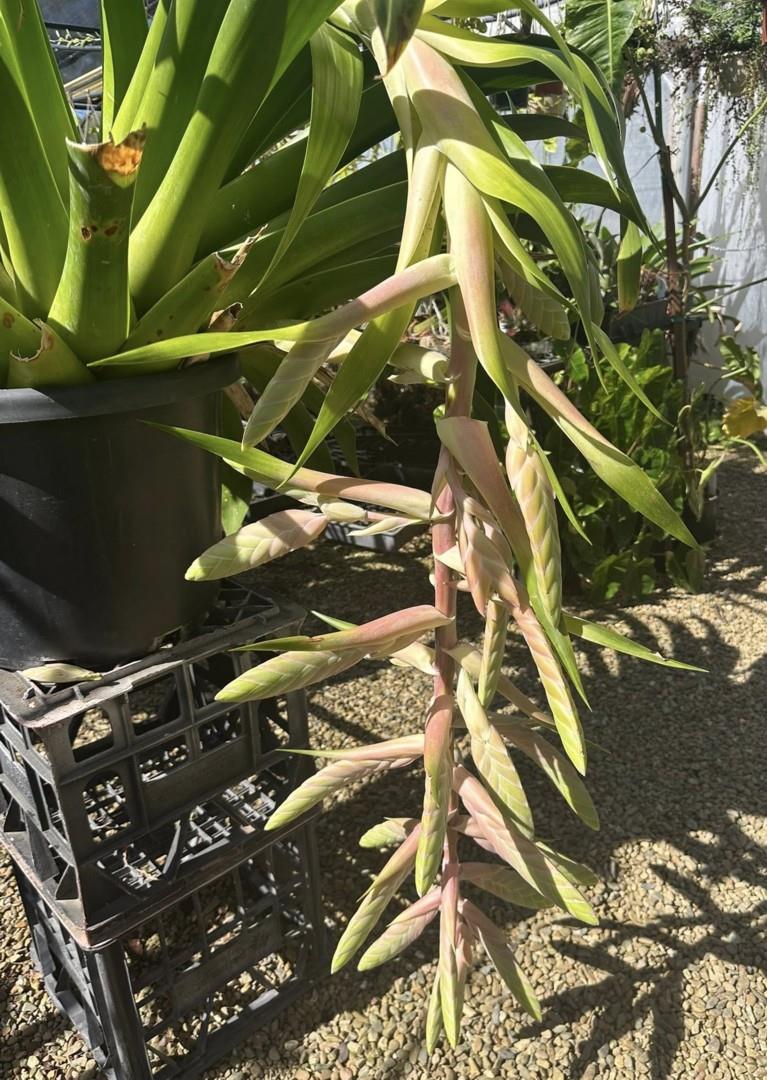
Plant stemless, but with a thick, rhizomatous base, flowering up to 80-100 cm high. Leaves numerous, forming an erect funnel form rosette up to 80 cm high and 60 cm in diameter.
Sheaths indistinct, broad-ovate, 12 cm long, 9 cm wide, densely pale brown lepidote on both sides, only somewhat contrasting with the blades; these up to 60 cm long, 7 cm wide (above the sheath), ligulate, acuminate, with a narrow hyaline margin, yellowish-green (in habitat), cretaceous, obscurely lepidote, becoming glabrous above.
Scape shorter than the leaves, erect at base, decurved in the upper third, thick, green to reddish.
Scape bracts subfoliaceous, densely imbricate, the basal ones yellowish-green, cretaceous, the upper ones with erect, rose sheath and spreading, triangular, yellowish-green cretaceous blade.
Inflorescence pendant, 80-100 cm long, laxly bipinnate with 5-8 spreading-to-decurved spikes
Primary bracts lanceolate, acute, much exceeding the short (3 cm), sterile, bracteate base of the spikes, the lower ones with big red sheath and yellow-green blade, the upper ones bladeless, acute, carmine-red, cretaceous.
Spikes complanate up to slightly convex, atanthesis up to 15 cm long and 3 cm wide, with 20-25 flowers arranged in distichous manner.
Floral bracts at anthesis densely imbricate, concealing the quadrangular, slightly flexuous, glabrous, cretaceous, red rachis, lanceolate, acute, carinate, up to 4 cm long, 2 cm wide, with a narrow, hyaline margin, obscurely lepidote, at anthesis bright carmine-red, cretaceous (postfloral white), exceeding the sepals, fresh even, but strongly nerved when dry.
Flowers up to 8 cm long, erect, contiguous, subsessile.
Sepals lanceolate, acute 3.5-3.8 cm long. 105 cm wide, coriaceous, the posterior carinate, free, obscurely lepidote, pale-red, brownish at the base and cretaceous, nerved when dry.
Petals narrow-lingulate, up to 7 cm long, 0.5 cm wide, erect, spreading at the tips, deep violet, whitish toward the base.
Stamens 1 cm long exserted, with white filaments and yellow anthers. Style exceeding the stamens, with violet stigmas.
Type. Pamela Koide (without coll. no. , May 1984), in herb. Inst. Syst. Bot. Univ. Heidelberg (HEID). Herbarium number B.G.H. 66 869.
Distribution. Saxicolous in steep rock cliffs, 1800 m alto, near the road Talpar de Allende (Ayutla, Jalisco, Mexico).
Tillandsia pamelae with its cretaceous, lingulate, nearly glabrous leaves, hanging inflorescences and long exserted stamens does not resemble any other Mexican Tillandsia. It does resemble the South American T. clavigera Mez, which also has reflexed inflorescences and spikes, but these are long-stipitate and the stamens equal the petals. It belongs, therefore, in the subgenus Tillandsia.
Like many other saxicolous tillandsias, T. pamelae also dies after fruiting, but it produces offshoots at the rhizomatic stembase before flowering. Another characteristic of T. pamelae is that the fertile organs lose their color in the postfloral state, becoming pure white; further, the spikes begin to elongate so that the inflorescence rachis becomes visible.
Notes from Macvaugh in Flora Novo Galiciana 1989
Tillandsia pamelae Rauh, J. Bromel. Soc. 36: 117. 1986.
Known only from the type-collection, the holotype from a cultivated plant (B. G. H.66 869, HEID), the original material collected by Pamela Koide from cliffs at 1800 m, near Ayutla, Jal., along the road to Talpa de Allende.
Plant acaulescent, large, with many leaves in a dense funnelform rosette up to 60 cm across, and the flowering stem up to 1 m long;
sheaths indistinct, broadly ovate, 12 cm long, 9 cm wide, pale brown-lepidote;
blades up to 60 cm long, 7 cm wide above the sheath, ligulate, excurrent at the acute apex, yellow-green, chalky white above, glabrescent;
scape shorter than the leaves, erect at base, decurved in the distal third;
scape-bracts subfoliaceous, imbricated, the upper ones with erect roseate sheath and spreading triangular blade;
inflorescence pendent, loosely compound with 5-8 spreading to decurved 20-25-flowered distichous spikes, these somewhat compressed, at anthesis up to 15 cm long and 3 cm wide; primary bracts lanceolate, acute, the lower ones {ca 5 cm long} longer than the sterile bracteate base of the spike, with red sheath and yellow-green blade;
floral bracts closely imbricated and concealing the rachis, lanceolate, acute, keeled, up to 4 cm long and 2 cm wide, obscurely lepidote, bright carmine-red (becoming white and chalky after anthesis), exceeding the sepals, even (smooth) when fresh, nerved when dry;
flowers up to 8 cm long, erect, contiguous, subsessile;
sepals lanceolate, acute, 35-38 mm long, coriaceous, obscurely lepidote, nerved when dry, the adaxial ("posterior") pair keeled, distinct:
petals erect, narrow, up to 7 cm long, 5 mm wide, deep violet;
stamens exserted 1 cm, the filaments white; style exceeding the stamens, the stigmas violet. {Description compiled.}
The author comments in the protologue that Tillandsia pamelae, "with its cretaceous, lingulate, nearly glabrous leaves, hanging inflorescences and long exserted stamens does not resemble any other Mexican Tillandsia." The distinction between ligulate and triangular leaf-blades is used by Smith in his later work (Smith & Downs, 1977) to separate a large number of species from the bulk of Tillandsia, but only a few of the ligulate-leaved species are known to be Mexican. The author of T. pamelae also comments on what seems to him a noteworthy feature, that the "fertile organs," by which he seems to mean the sepals and floral bracts, "lose their color in the postfloral state, becoming pure white."